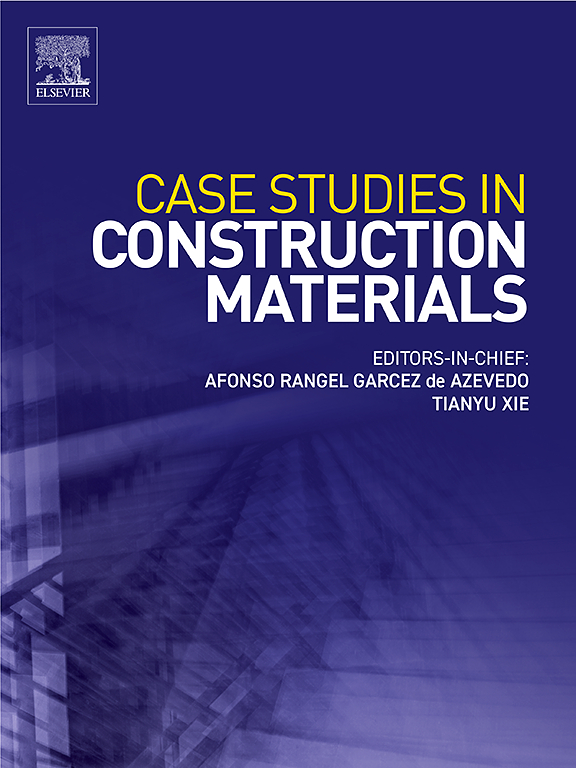冻融环境下掺气再生砖骨料混凝土的优化利用
IF 6.6
2区 工程技术
Q1 CONSTRUCTION & BUILDING TECHNOLOGY
引用次数: 0
摘要
利用再生砖骨料(RBA)为建筑和拆除废物(CDW)带来的环境挑战提供了可持续的解决方案。然而,RBA的高吸水率和高孔隙率会加速冻融损伤,导致骨料和混凝土基体的显著劣化,从而影响结构的完整性。虽然空气夹带已被证明对天然和再生混凝土骨料混凝土有效,但其在再生砖骨料混凝土(RBAC)中的应用仍未探索。本研究探讨了夹带空气增强RBAC抗FT的有效性。制备了12种不同w/c比(0.55、0.45和0.35)和RBA取代水平(0 %、25 %、50 %和100 %)的带气RBAC混合物,并进行了300次快速FT循环。结果表明,尽管含有空气,但RBA对RBAC的抗FT阻力有不利影响,这可以通过增加质量损失、降低RDME和降低抗压强度来证明。然而,携风与低w/c比的组合有效地减缓了FT循环过程中冰膨胀引起的内部劣化。汞侵入孔隙学(MIP)分析显示,FT循环后0.35A-RBA-0和0.35A-RBA-100试样的孔径分布变化相似,而0.45和0.55 w/c比的RBAC试样中孔和大孔(有害孔>;100 nm)明显扩大。x射线计算机断层扫描(XCT)分析证实,在低w/c比下,尽管局部RBA开裂,但夹带空气仍使砂浆基质免于开裂。开发的FT损伤模型证实,与NAC相比,RBAC的使用寿命减少了46% %,具体取决于w/c比。因此,建议将RBA含量限制在50 %,同时保持低w/c比率在0.45或以下,特别是在耐FT性至关重要的寒冷地区。这些发现为在寒冷气候下优化RBAC混合设计、推进可持续性和促进建筑行业的循环经济实践奠定了指导方针。本文章由计算机程序翻译,如有差异,请以英文原文为准。
Optimization and utilization of air-entrained recycled brick aggregate concrete under freeze-thaw environment
Utilizing recycled brick aggregate (RBA) offers a sustainable solution to the environmental challenges posed by construction and demolition waste (CDW). However, the high water absorption and porosity of RBA accelerate freeze-thaw (FT) damage, leading to significant deterioration of both the aggregate and the concrete matrix, which compromises structural integrity. While air-entrainment has proven effective for natural and recycled concrete aggregate concrete, its application to recycled brick aggregate concrete (RBAC) remains unexplored. This study investigates the effectiveness of air-entrainment in enhancing the FT resistance of RBAC. Twelve air-entrained RBAC mixtures with varying w/c ratios (0.55, 0.45, and 0.35) and RBA substitution levels (0 %, 25 %, 50 %, and 100 %) were prepared and subjected to 300 rapid FT cycles. The results showed that RBA has a detrimental effect on the FT resistance of RBAC despite air-entrainment as evidenced by the increased mass loss, reduced RDME, and reduction in compressive strength. However, the combination of air-entrainment with low w/c ratio effectively moderated internal deterioration caused by ice expansion during FT cycling. Mercury intrusion porosimetry (MIP) analysis showed similar alteration in pore size distribution between the 0.35A-RBA-0 and 0.35A-RBA-100 specimen after FT cycling, while RBAC specimens with 0.45 and 0.55 w/c ratio showed significant expansion of mesopores and macropores (harmful pores >100 nm). X-ray computed tomography (XCT) analysis confirmed that air-entrainment preserved the mortar matrix from cracking despite localized RBA cracking at low w/c ratio. The developed FT damage model confirmed up to 46 % reduction in service life of RBAC compared to NAC, depending on w/c ratio. Therefore, it is recommended to limit the RBA content to 50 % while maintaining low w/c ratio at or below 0.45, particularly in cold regions where FT resistance is critical. These findings establish guidelines for optimizing RBAC mix design under cold climates, advancing sustainability and promoting circular economy practices in the construction sector.
求助全文
通过发布文献求助,成功后即可免费获取论文全文。
去求助
来源期刊

Case Studies in Construction Materials
Multiple-
CiteScore
7.60
自引率
19.40%
发文量
842
审稿时长
63 days
期刊介绍:
Case Studies in Construction Materials provides a forum for the rapid publication of short, structured Case Studies on construction materials. In addition, the journal also publishes related Short Communications, Full length research article and Comprehensive review papers (by invitation).
The journal will provide an essential compendium of case studies for practicing engineers, designers, researchers and other practitioners who are interested in all aspects construction materials. The journal will publish new and novel case studies, but will also provide a forum for the publication of high quality descriptions of classic construction material problems and solutions.
 求助内容:
求助内容: 应助结果提醒方式:
应助结果提醒方式:


